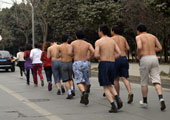
The US model
In developing its own internal market, China should follow the US model, Lu suggests - that is, to build up an integrated market with free flows of labor, capital and land use rights.
In China, the government should move quickly to abolish all impediments to the free movement of labor, most notably its hukou (household registration) system.
There are estimated to be 250 million migrant workers who currently work and pay tax in cities, who still have their hukou registered in their home villages, often in rural areas.
This denies them the same social security, education and healthcare benefits as registered urban residents.
Lu said the current wage increases being seen in the eastern cities are actually little more than "compensation" towards what migrant workers are being charged for their public services.
The wage increases also simply reflect the shortage of labor in many cities, because fewer migrant workers are willing to accept the terms being offering.
Those wage increases are no reflection, however, on the high level of skill and productivity being brought to the job by many migrant workers, he added, which in the long run can only be economically dangerous.
Only around half of China's population currently lives in cities. If migrant workers were given access to the same public services as city residents, the country's urbanization ratio could be lifted by at least 10 percentage points, Lu added.
He said those who oppose reform of the hukou system are shortsighted in their failure to understand that city economies would benefit hugely by more people being able to work in them, with all the benefits included.
They would spend more on products and services, for instance, and property demand will rise.
If more people remained in under-developed agrarian provinces, local governments, in turn, would need to create more industrial jobs for them by asking for financial support from the central government, inevitably adding to the tax burden from the already developed provinces.
If more people migrate to the developed provinces and settle down, pressure would ease on officials to create so many industrial jobs.
With smaller populations, the rural provinces may also seek development in relatively easier and more competitive ways, such as in modern agriculture and tourism.
The productivity per capita of those provinces may rise more rapidly as a result, narrowing the gap with developed industrial provinces, without being forced to attempt to copy their business models.


















 Surrealistic impression shown in fog
Surrealistic impression shown in fog


![]()
